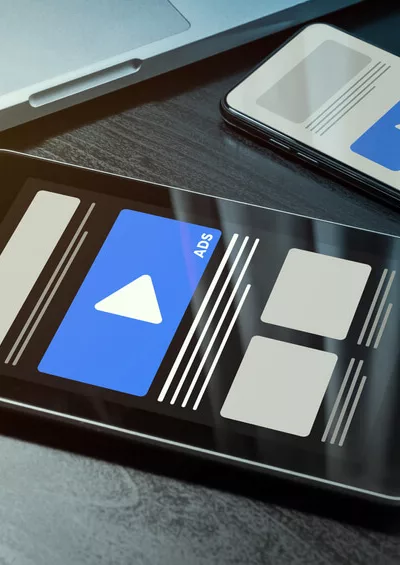Marketers spent more than $7 billion on digital local advertising in 2016, and experts predict that figure will grow by an additional $3 billion between 2017 and 2021. We’ve packed this user-friendly guide with essential info about local advertising so you can decide whether it deserves a spot in your marketing plan.
While we always advocate naturally building trust with your audience via content and other engagement, local marketing is a solid way to cast a net for new audience members. Remember that any type of advertising today has to be backed up with organic customer relationship approaches.
What is local advertising?
Local advertising lets you share important messages with a small yet relevant audience. Some marketers solely rely on local advertising, while others combine it with national or global marketing to target a widespread group of readers.
“Local” is a subjective term that refers to people who work, live, or socialize near your business. You may consider someone local if they are within 10 miles of your company, while other marketers might focus on folks who have located up to 100 miles away.
The Agricultural & Applied Economics Association explains that in geographic terms, “local” typically refers to places within 100 miles but may extend up to 400 miles. This association focuses on food-related concepts, but its definition is still relevant in the marketing world.
Figure out what “local” means to you, and adapt your marketing plan accordingly. You aren’t limited to a specific proximity, so feel free to experiment with different distances. You may find it helpful to create different local ads for readers that fall within certain distances from your company, such as:
- 1 to 10 miles
- 10 to 25 miles
- 25 to 50 miles
- 50 to 100 miles
- 100 to 400 miles
Creating unique ads for different areas helps you figure out which readers are interested in your company and learn how far they’re willing to travel for the goods or services you offer.
If you manage a brick-and-mortar business remotely, you might be wondering which cities to target. Luckily, you don’t have to know much about the area surrounding your business when you create local ads. Advertising networks like Google Adsense use cookies to track the habits and estimated location of readers.
Google also uses internet traffic information and implicit location information to learn where people spend their time. Internet traffic information identifies your country via an IP address so that Google can customize your browsing experience. If you enable device-based location services on a smartphone or tablet, Google can pinpoint your exact location using cell phone towers and Wi-Fi access points.
Your device typically stores this information unless you tweak your settings to make sure it erases data from location services. Even if you erase this data, Google might still know your current location. If you perform a regular internet search during this time, even without location services enabled, Google may receive information about your geographic location. That’s why typing in a question like “How much does a plumber cost?” often pulls up websites for contractors in your area. You may also notice this happens if you enter a phrase like “buy cute sneakers” or “What’s the best laptop for kids?”. All of this technology can be put to work in your own local marketing efforts.
Let’s say that you own a small candy shop in St. Louis, Missouri, that sells handcrafted caramels dipped in creamy milk chocolate. When you launch a local advertising campaign, you have a few different options. You can tell your advertising network to show an ad for your candy shop when people within a specific distance, such as 25 miles or less, search for phrases like “sea salt caramels” or “gourmet chocolate.” If you’re worried a large chunk of readers might disable device-based location services or cookies, you can also target local keywords, such as “candy shop in St. Louis” or “Missouri caramels.”
But what if your candy shop ships to far-away places? You can combine local advertising with traditional search ads so that readers around the country – or even the globe – have access to your delicious chocolate-covered caramels. You can even target specific age groups, genders, or incomes, such as females aged 18 to 35 who have an annual income of at least $48,000, when you create a marketing campaign. This ensures that you get info about your business in front of the people who are most likely to want what you offer, and it also lets you experiment with different demographics to learn more about potential customers.
For example, you might learn that 55-year-old men who earn $30,000 per year love your handmade candy, while women who are 35 to 45 years old typically click on your ads but don’t buy any chocolate. When you know which readers want your products, you can tailor your ads accordingly.
What are the best ways to advertise locally?
There are multiple methods of local advertising. We’ve already discussed Google advertising, but we’ll delve into more details about that well-known approach in this section. Other popular methods of local advertising include TV advertising, newspaper advertising, mobile advertising, hyper-local advertising, and Amazon local advertising.
TV advertising
Think about the commercials that you see when you watch your favorite television show. You probably see a mix of nationwide ads and local ads. Nationwide commercials are for goods or services that you can purchase nearly anywhere, such as cans of Pepsi or oil-change services from a company with numerous locations scattered across the United States. Local ads are commercials that are relevant to you but might not interest viewers located in another state. Examples of local commercials include ads for HVAC services, nearby restaurants, and community colleges.
Advertising on television can get expensive during a nationwide campaign, but prices are comparable to other methods of advertising if you stick with local ads. You might rack up a $400,000 bill for a 30-second commercial shown nationwide during a popular television series, while a local commercial may cost just $25 for every thousand impressions.
Prices for television commercials vary drastically because numerous factors influence the final cost of a TV ad. When you reserve a slot for a TV commercial, expect the following factors to affect your cost:
- Time – Are you advertising your business during prime time, or do you want to place an ad when most viewers are sleeping?
- Station – Are you using a local station, or do you want to advertise on a cable network?
- Month – Are you promoting seasonal specials around Christmas or Valentine’s Day, or can your ad be shown any time of the year?
- Show Popularity – Do you want to target a large audience, or are you sharing your commercial during a show that doesn’t have a loyal fan base?
Other factors, such as whether you plan to show local ads in a big city or a small, close-knit community, may affect your price. You can contact different networks and compare prices before you commit to a time slot.
It’s also important to remember that television ads typically require a specific format and time frame. You may have to limit your ad to 15, 30, or 45 seconds depending on the time and day that you advertise. If you prefer more freedom with your advertising, you may find it easier to run a local advertising campaign via Google or Amazon.
Google advertising
Google advertising helps you reach local readers via laptops, desktops, tablets, and smartphones. Unlike TV commercials, your readers do not have to tune into a specific channel at a specific time to view your ad. With Google advertising, you go where your viewers are rather than expecting them to come to you.
As we explained earlier, Google uses innovative tracking methods to monitor what internet users are doing at any given moment. This offers flexibility and freedom for marketers because you don’t have to say, “Okay, I need to show this 87-word ad at 7:47 p.m. and hope that nobody is in the bathroom or distracted by children or a significant other when the ad appears.” Your advertisement pops up whenever Google’s impressive algorithm thinks readers can benefit from the information, whether they’re planning a mid-month trip to the area surrounding your business or currently hanging out with friends 2 miles away from your company.
Prices vary for Google ads, but you have the option to pay for impressions or clicks. An impression occurs whenever someone views your advertisement, even if they just look at it for a second. Clicks refer to times when a viewer clicks through on the ad to find out more details.
When you set a budget for your advertising campaign, Google honors it. This helps prevent unpleasant surprises as you execute your marketing program.
Newspaper advertising
American adults spend more than 11 hours per day engaging in electronic media, but there are still folks who prefer to read printed content. You can reach these readers by publishing local ads in a newspaper.
Ad Age reports that it costs approximately $50,000 for a full-color ad on the front of The New York Times, but that’s a large newspaper with a nationwide audience. Expect to spend significantly less if you advertise in a local newspaper, especially if you do it on a weekday. Prices may increase during the weekend if you’re posting an ad in a paper that includes coupon leaflets or glossy store ads or reaches more readers on Saturdays and Sundays.
The location of your ad also affects its price. A small ad in the corner of a page probably won’t cost as much as a full-page ad near the front of the paper. If your ad includes graphics, you may pay more for color images than black-and-white pictures.
If newspapers aren’t popular in your area, consider a newsletter. You can share coupons or promo codes in a local newsletter that is distributed to every resident of the city. Businesses commonly found in these newsletters include chiropractors, restaurants, and daycare facilities.
Mobile advertising
Customers often start their browsing process on a desktop or laptop. They carefully click through multiple pages, comparing the prices and features of items that interest them. If you sell products online, this is good news for you. If you’re trying to get people to visit a brick-and-mortar building, make sure you target smartphone and tablet users. This is known as mobile advertising.
Mobile advertising helps you reach customers who want to buy something by presenting your ads while they’re on the go. If you sell Italian food, your ads might encourage a hungry family in your area to stop in for pizza. If you offer massage services, stressed men and women near your wellness center can quickly find you and schedule a visit.
Hyperlocal advertising
Hyperlocal advertising is a form of mobile advertising that targets potential customers in real time. This marketing method applies local data, such as whether it’s sunny or rainy, to help drive visitors to your business.
Content from our partners
You can also use hyperlocal advertising when you launch desktop campaigns, but you may prefer to focus on mobile users. This method of advertising is highly targeted, so it works well with consumers who are already near your business.
Advertisers use beacons and geofencing technology to find people who are very close to your company or engage customers who are currently at your place of business. Beacons are compact devices scattered throughout an establishment that sends signals through Bluetooth. Smartphone apps pick up these signals and notify customers about special deals.
Geo-fencing relies on GPS tracking within a specified radius to attract potential customers. Walmart and Starbucks use geo-fencing to attract and retain customers.
Local advertising ideas and examples
Sometimes local advertisements make national news. In early 2017, a low-budget commercial for an animal shelter garnered millions of views after circulating on social media. FurKids, which produced the popular Kitty Kommercial, jokes that the commercial was super cheap, with production costs of “a couple cans of cat food for the cat stars.” The company filmed the entire commercial, which was improvised rather than scripted, in just 30 minutes.
You may have also heard about Nationwide Insurance’s “Life Comes at You Fast” display in Columbus, Ohio. Ten years later, marketers around the world still praise the clever execution of this paint-drenched billboard and its prop cars.
Here are some tips on how to create your own memorable local advertising campaign:
- Get creative with your advertising medium. If it’s legal in your area, consider sharing your message via street art.
- Use inside jokes that local residents understand. If the city jokes that residents need heat and air conditioner on the same day, you can use that to promote clothing or HVAC services.
- Mention local sports teams or celebrities in your campaign. Remember, you may have to request permission from a team or individual before you do this.
- Keep it civil. Don’t bash local mom-and-pop restaurants or do anything to upset your viewers when you promote your own products or services.
Curious which marketing methods don’t do well? Visit Reddit for a cringe-worthy compilation of awful commercials, many of which are from local advertising campaigns. Watch some of these videos before you create your own commercial so you know which mistakes to avoid.
Approximately 80% of Internet users search for local data. If you ignore this statistic, then you might neglect a large chunk of potential customers when you promote your company. Capture the interest of local shoppers and drive them to your business to make a purchase when you utilize multiple methods of local advertising.












